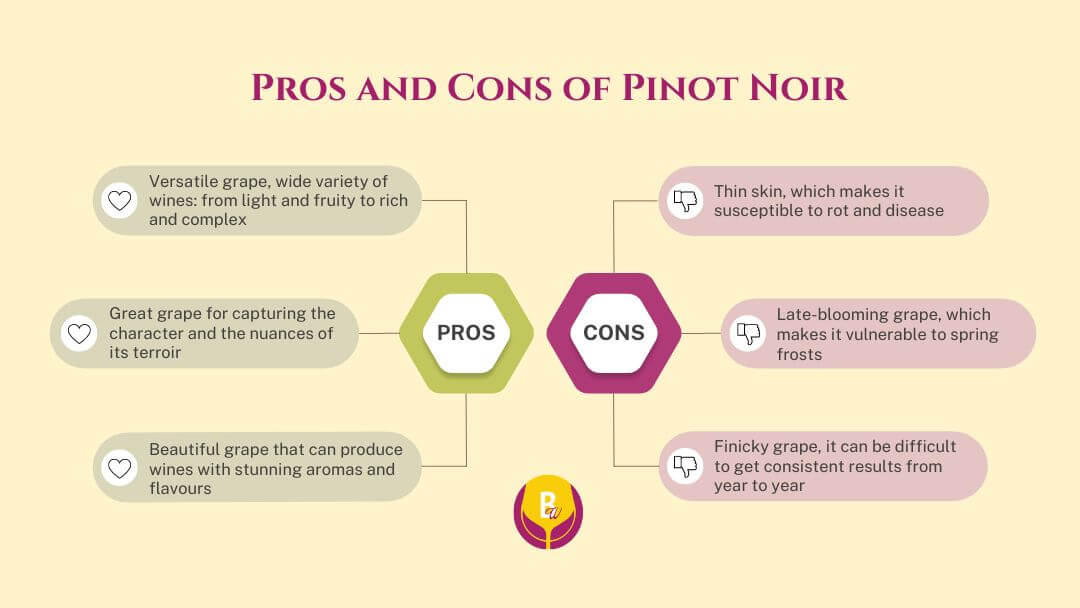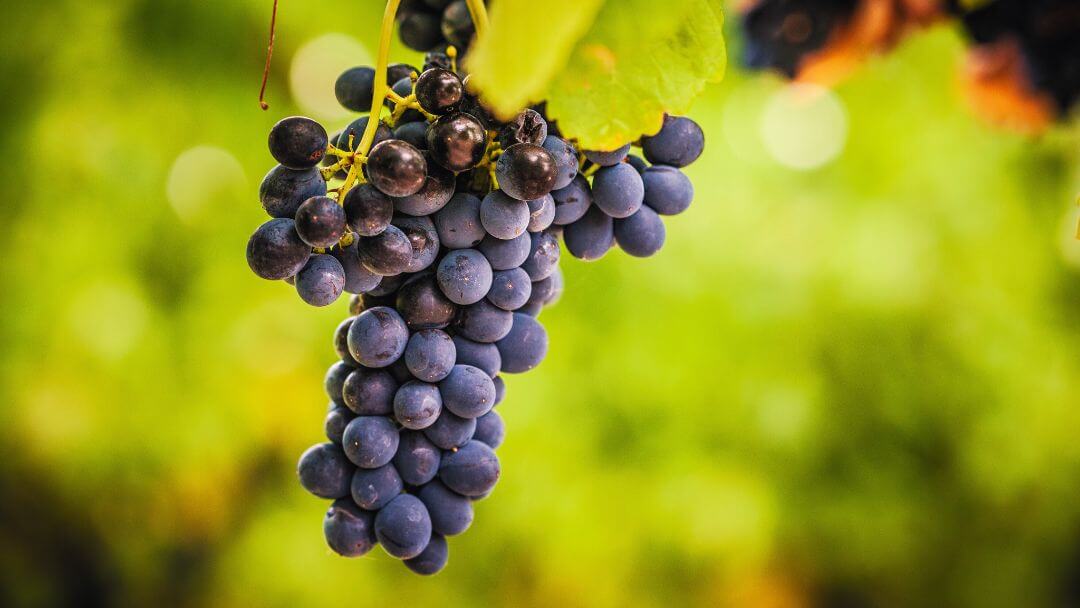Few grape varieties captivate the senses and challenge the winemaker’s art quite like Pinot Noir – The Heartbreak Grape. This elegant and fickle grape is renowned for producing some of the world’s most exquisite wines, so it’s worth the trouble! And guess what? Today is International Pinot Noir Day, so grab a glass and enjoy the reading! Gotta be special to have your own day!
Meet Pinot Noir
Pinot Noir, often referred to as the “heartbreak grape,” is a red grape variety known for its thin skin and delicate nature. It’s notoriously challenging to grow and cultivate! Its thin skin makes it susceptible to pests and diseases and it is highly sensitive to changes in weather and climate. This mix can lead to unpredictable yields and quality variations, making it a difficult grape for winemakers to work with. It thrives in cooler climates and is widely celebrated for the complexity and finesse it imparts to the wines it creates.
Despite the challenges, winemakers and enthusiasts are drawn to Pinot Noir for its exceptional and complex flavours, which make it all the more rewarding when successfully cultivated and crafted into a beautiful wine. The wines made from Pinot Noir are usually light to medium-bodied, with a mesmerising array of aromas and flavours.
The name “Pinot Noir” derives from the tightly-packed and compact shape of its grape clusters, resembling a pine cone. This grape variety has a unique anthocyanin component, contributing to the wine’s discreet transparency and shallow ruby tones, making it easily identifiable. It is known for its refined characteristics, with tannins and structure that are more composed rather than bold and overpowering.
Pinot Noir is versatile in winemaking, as it is vinified in white to produce single-variety sparkling wines and blended with other grapes to add body, persistence, and structure to various cuvées. In Italy, the Oltrepò Pavese region boasts the largest extension of Pinot Noir vineyards, followed by Valle d’Aosta, Trentino Alto-Adige, and the territory of Breganze.

A bit of History
Pinot Noir’s history dates back to the Roman era, and it has been a cornerstone of winemaking in Burgundy since the Middle Ages. The grape’s reputation slowly spread beyond France, with monks and merchants carrying cuttings to other European regions. In the 19th century, it found its way to California and other parts of the New World, where it adapted to new terroirs.
Global Cultivation
Pinot Noir finds its origins in the Burgundy region of France, where it has been cultivated for centuries. Today, it is grown in vineyards around the world, from the Old World wine regions of Europe to the New World terroirs of North and South America, Australia, New Zealand and even emerging wine regions in Asia.
Different Names in Different Countries
Pinot Noir – the Heartbreak Grape, is celebrated by various names in different parts of the world. In Germany, it is known as Spätburgunder, while in Italy, it goes by Pinot Nero. In Switzerland, it is called Blauburgunder, and in Austria, it is known as Blauer Burgunder. You can also find Pinot Noir as Rulandské Modré in Czech Republic and Slovakia, Modri Pinot in Slovenia, Pinot Crni in Croatia and Kék Burgundi in Hungary. These names are a testament to the grape’s global reach and popularity.
Best Expression and Results
While Pinot Noir is grown in numerous countries, it is undoubtedly Burgundy, France, that showcases its most exceptional expressions. The terroir of Burgundy, with its limestone-rich soils and unique microclimates, offers an unparalleled stage for Pinot Noir to flourish. The Burgundian wines are often described as benchmarks, epitomising the grape’s true essence.
10 Popular Pinot Noir Wines
Popular Pinot Noir wines you might have heard of:
- Domaine de la Romanée-Conti (Burgundy, France)
- Domaine Armand Rousseau Chambertin (Burgundy, France)
- Maison Joseph Drouhin Clos des Mouches (Burgundy, France)
- Domaine Leroy Musigny (Burgundy, France)
- Kosta Browne Pinot Noir (California, USA)
- Merry Edwards Russian River Valley Pinot Noir (California, USA)
- Felton Road Block 3 Pinot Noir (Central Otago, New Zealand)
- Ata Rangi Pinot Noir (Martinborough, New Zealand)
- Cloudy Bay Pinot Noir (Marlborough, New Zealand)
- Au Bon Climat Pinot Noir (Santa Barbara County, California, USA)
Colour, Aroma and Taste
The typical colour of Pinot Noir wine is a translucent ruby-red, sometimes exhibiting a slight garnet hue with age. As for fragrances, Pinot Noir offers an enchanting bouquet that can include ripe red fruit notes such as cherry, raspberry, and strawberry, often accompanied by floral undertones of violets and rose petals. There might be hints of cranberry and pomegranate as well.
On the palate, Pinot Noir exhibits a symphony of flavours. Red fruit flavours continue to shine, accompanied by a medley of berries and plums. There is a sense of elegance with a fine balance between fruitiness and earthiness. The wine’s silky texture and refined tannins offer a smooth and velvety mouthfeel.
The “earthiness”, often referred to as “forest floor” or “wet leaves,” can reveal intriguing earthy undertones. Notes of damp earth, mushrooms, and hints of undergrowth add layers of complexity to the wine. Subtle yet alluring spices, such as clove, cinnamon, and a dash of white pepper, add a touch of warmth to the wine, contributing to its overall charm.
One of Pinot Noir’s defining characteristics is its vibrant acidity, which provides a lively and refreshing sensation on the palate. This acidity contributes to the wine’s ability to pair well with a variety of dishes.
On top of that, Pinot Noir typically boasts a lingering finish with a delightful interplay of fruit and subtle earthy nuances. The wine’s finish is often described as elegant and enduring, inviting another sip.
Overall, Pinot Noir = red fruit + earthy undertones + gentle spices, all wrapped in a velvety texture with vibrant acidity.
Different Production Areas, Different Pinot Noir
Pinot Noir – the Heartbreak Grape, exhibits fascinating variations in taste, aromas, and colours depending on the production area, offering wine enthusiasts an exciting spectrum of options to explore.
- FRANCE – BURGUNDY: The birthplace of Pinot Noir, Burgundy, produces wines with exceptional elegance, bright red fruit flavours, and subtle earthy undertones. Wines from Côte de Nuits showcase a rich, complex profile, while those from Côte de Beaune often display a delicate and floral character.
- UNITED STATES – OREGON: Oregon’s Pinot Noir tends to exhibit ripe red fruit flavours, such as cherry and raspberry, with vibrant acidity and a refined structure. The cool climate of the Willamette Valley contributes to wines that strike a balance between fruitiness and earthiness.
- UNITED STATES – CALIFORNIA: California Pinot Noir tends to be fruit-forward with flavours of ripe black cherries and plums. The wines often have a rounder, more opulent mouthfeel compared to their European counterparts.
- NEW ZEALAND: Pinot Noir from Central Otago in New Zealand displays bold fruit flavours, such as blackberry and plum, with a distinctive spiciness. The wines from Marlborough showcase bright acidity and red fruit notes.
- CHILE: Chilean Pinot Noir is known for its good value and fruit-forward character. Depending on the region, wines can vary from lighter styles with red fruit flavours to more concentrated expressions with black fruit notes.
- GERMANY: German Pinot Noir, known as Spätburgunder, often exhibits a lighter body with red fruit aromas and a touch of spiciness. These wines can be charming and delicate.
- AUSTRALIA: Pinot Noir from cooler regions in Australia, like Tasmania and Mornington Peninsula, offers red fruit flavours and a balanced acidity. These wines can rival some of the best Pinot Noirs from around the world.
- ITALY: Italian Pinot Noir, known as Pinot Nero, showcases its own distinct characteristics that add to the fascinating diversity of this grape:
- Lombardia – Oltrepò Pavese: Pinot Nero from the Oltrepò Pavese area in Lombardia exhibits a delicate and refined profile. The wines tend to have floral aromas, like violets, and an alluring red fruit bouquet, accompanied by subtle earthy undertones. If you’re in Oltrepò Pavese, you should try “Oltrepò Pavese Metodo Classico DOCG”, which is a sparkling wine made from (at least 70%) Pinot Nero and “Franciacorta DOCG”.
- Valle d’Aosta: it offers a distinctive expression shaped by the unique terroir of this mountainous region. Valle d’Aosta is Italy’s smallest region, located in the northwestern part of the country near the borders of France and Switzerland. The high altitudes and cool climate of the Alpine valleys create ideal conditions for cultivating Pinot Noir grapes. Valle d’Aosta‘s Pinot Noir wines are known for their elegance, finesse, and bright acidity. They typically showcase delicate red fruit flavours, such as cherries and raspberries, with hints of floral and earthy notes. The wines often have a light to medium body, reflecting the cooler climate and the influence of the surrounding mountains.What sets the region’s Pinot Noir apart is its pronounced minerality and distinctive mountain character. The stony and mineral-rich soils of the region, combined with the diurnal temperature variations, contribute to the wine’s unique sense of place. These elements give the wines a sense of purity and terroir-driven identity that wine enthusiasts appreciate. Due to the challenging terrain and limited vineyard space in Valle d’Aosta, the production of Pinot Noir is relatively small compared to other regions.
- Alto Adige: Pinot Nero from the northern region of Alto Adige (South Tyrol, Südtirol) benefits from its Alpine location, resulting in wines with bright acidity and pronounced mineral notes. The cooler climate contributes to the wine’s elegant red fruit flavours, such as cherries and raspberries, and often a touch of spiciness.
- Friuli-Venezia Giulia: Pinot Nero from Friuli-Venezia Giulia in northeastern Italy expresses a rich and complex personality. These wines display red fruit flavours with a touch of dark fruit, like blackberries and black cherries. The region’s unique terroir imparts a captivating mix of spice and floral notes.
- Veneto: In the Veneto region, Pinot Nero produces wines with a fresh and fruity character. These wines are typically easy-drinking and can offer a delightful balance of red fruit flavours and floral hints.
- Tuscany: Pinot Noir is also cultivated in some areas of Toscana, where it thrives in the cooler microclimates. The wines from this region are often medium-bodied, featuring red fruit flavours, and may showcase a hint of herbal and undergrowth notes, reflecting Tuscany’s diverse terroir.
In 2021, there were 18,300 hectares of Pinot Nero planted in Italy, accounting for 3.2% of the total vineyard area in the country. On top of that, 1.2 million hectolitres of Pinot Nero were produced, accounting for 2.3% of the total wine production in the country.
Pairings
Pinot Noir’s versatility in taste and moderate tannin levels make it an excellent choice for food pairings. Its light to medium-bodied nature allows it to complement a wide range of dishes. For a classic pairing, consider enjoying a glass of Pinot Noir with grilled or roasted salmon. The wine’s red fruit flavours and delicate spiciness beautifully enhance the richness of the fish. Additionally, Pinot Noir pairs wonderfully with other seafood like tuna, swordfish, and shellfish.
If you prefer poultry, opt for roasted chicken or turkey, as the wine’s subtle earthiness harmonises with the savoury flavours of the meat. For a vegetarian option, pair Pinot Noir with mushroom-based dishes, such as wild mushroom risotto or mushroom stroganoff, accentuating the earthy notes present in both the wine and the food. Furthermore, this wine pairs excellently with various cheeses, particularly soft cheeses like brie and camembert.
Pinot Noir – the Heartbreak Grape is one of the most compelling and enchanting grape varieties in the world of wine. Its ability to convey the nuances of terroir and captivate the senses with its aromatic complexity make it an eternal favorite among wine enthusiasts and a challenging pursuit for winemakers. Whether it’s a prestigious Burgundy from France or an innovative New World expression, Pinot Noir continues to weave a spell of allure and fascination in every glass.











